27 October 2023
The hub has recently funded a second round of research projects for 2023, with 13 new projects getting underway. These projects will continue to make innovative and meaningful progress in supporting research that improves the management of Australia’s terrestrial and freshwater ecosystems.
The hub has recently funded a second round of research projects for 2023, with 13 new projects now underway. These projects will continue to make innovative and meaningful progress in supporting research that improves the management of Australia’s terrestrial and freshwater ecosystems.
The development of our new research plan has – as always – been informed by the objectives, targets, priority species and priority places of the Australian Government’s Threatened species action plan 2022–2032.
Projects in this plan will support the improved management of national parks and other conserved areas across Australia and generate valuable data about threatened species and the steps we can take to help them survive and recover. This research plan also supports collaborative and Indigenous-led projects which are using Indigenous knowledge to address key environmental challenges.
Click the links below to find out more about our new research projects.
Assessing the impacts of myrtle rust on forest dynamics and function
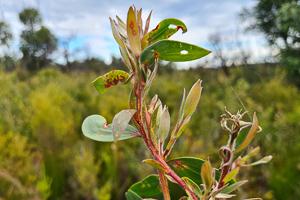
Melaleuca quinquenervia with myrtle rust. Photo: Geoff Pegg.
Australian World Heritage listed forests are under threat from myrtle rust, a fungal plant disease. The invasive disease has been spreading since its detection in 2010 and is devastating populations of Australian Myrtaceae species such as eucalypts, bottlebrush, paperbark, tea-tree and lilly-pilly. Our project is finding out what makes forests in NSW and Qld susceptible to myrtle rust, what the consequences would be of losing entire species from those forests, and what we can do to prevent that happening.
Informing management of feral cats and foxes in priority areas
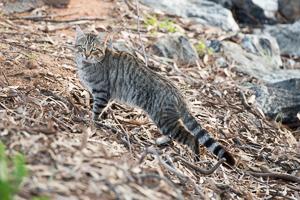
Feral cat on the banks of Menindee Lakes, NSW. Photo: AdobeStock.
Feral cats and red foxes pose serious threats to biodiversity and ecosystem health across Australia. On Kangaroo Island (SA) and in the Fitz-Stirling region (WA), significant efforts have been made to prevent these pests from harming local wildlife, but key knowledge gaps still limit best practice. Our researchers are working with local land managers to fill these gaps and determine the best ways to deal with feral cats and foxes on Kangaroo Island and in the Fitz-Stirling region.
Best-practice fox control in Booderee National Park

Fox in Booderee National Park. Photo: Parks Australia.
Attempts to reintroduce locally extinct species to Booderee National Park have been repeatedly hampered by fox incursions and subsequent catastrophic predation. Plans to reintroduce the eastern quoll – a priority species under the Australian Government’s Threatened species action plan 2022–2032 – have prompted new research to help mitigate the threats posed by foxes in Booderee. Our researchers will be working collaboratively with local land managers to better understand fox ecology and establish best-management practices.
Supporting Indigenous fire management through collaborative socio-ecological partnerships
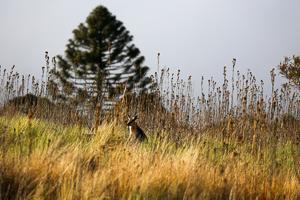
Bunya mountains grassy bald that has recently been burnt with a red necked wallaby and a Bunya tree. Photo: Richard Unwin.
Inappropriate fire regimes threaten the biodiversity and evolutionary capacity of natural ecosystems. First Nations people have been managing the interactions between fire and County for tens of thousands of years, ensuring ecosystem health and longevity. We’re supporting Indigenous land and fire management groups to better understand the ecological and evolutionary benefits of cultural burning in forests and grasslands in southern Queensland, including Bonye Biar (Bunya Mountains), and how collaborative partnerships can support cultural burning.
Experimental translocations to understand and combat declines of eastern quolls
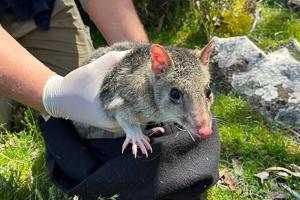
Neville, a captive-bred eastern quoll alive after 2 years in the wild. Photo: Aimee Bliss.
The eastern quoll, a native species that was once found throughout south-eastern Australia, now survives in the wild only in Tasmania. Even there, it is in decline. Our researchers are introducing captive-bred quolls to bolster wild populations in Tasmania and to determine what factors are contributing to quoll population decline. They also hope to establish a framework for using translocation as an early-intervention strategy to help boost quoll numbers and help other species in the early stages of decline.
Developing a National Indigenous Environmental Research Network

Australian Outback Sunset. Photo: Yay Images AdobeStock.
A lack of investment and resources allocated to the meaningful engagement of local Indigenous organisations in environmental research has led to national environmental research priorities that mostly lack Indigenous-led aspirations and place-based research priorities. Our researchers are investigating the establishment of NIERN – the National Indigenous Environmental Research Network – which will promote Indigenous inclusion and guide the relationship between Indigenous organisations, researchers, policy-makers and environmental management practitioners.
Recognising culturally significant entities
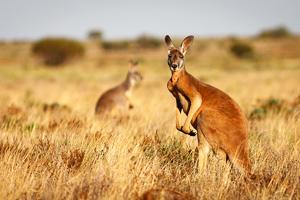
Red Kangaroo, Flinders Ranges National Park, South Australia. Photo: Luke AdobeStock.
When policy-makers are deciding how species and ecological communities should be managed or protected, the cultural significance of these species and communities is often overlooked. Our researchers are working to establish a consistent definition for culturally significant entities. That definition will be used to ensure that Indigenous Knowledge and considerations of cultural significance are integral parts of environmental policy-making processes and recovery strategies.
Improving environmental outcomes on conserved and managed lands
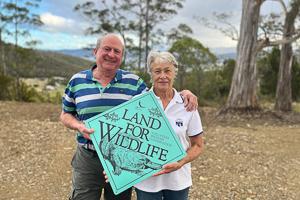
Land for Wildlife participants. Photo: Phil Wise.
The Australian Government has committed to protecting 30% of our land and sea environments by 2030, as part of the Kunming–Montreal Global Biodiversity Framework. This means including areas of conservation that are on private lands. Our project will review private-land conservation programs against the Australian criteria to see if they meet the conservation standard. We will also be performing place-based research to help improve the conservation practices of those that don’t.

Environmental Rehabilitation Area. Photo: Adwo AdobeStock.
Nature, people and economies depend on biodiversity to adapt to the threats posed by climate change. For natural resource management (NRM) organisations to protect Australia’s biodiversity and landscapes, long-term funding and investment are essential. We’re working to adapt and enhance NRM planning processes to ensure long-term benefits from investment. This will mean that land-management strategies can be fully implemented to protect Australia’s biodiversity.
Climate-resilient landscapes: an adaptation case study in NSW’s Northern Rivers region
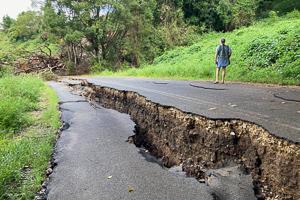
Landslide after the big flood on the road between Goonengerry and Federal in the Northern Rivers region. Photo: Brendan Mackey.
The Northern Rivers region of New South Wales is home to many culturally significant entities, threatened species and threatened ecological communities at risk of extinction and degradation from climate change. By identifying focal species and through co-design with communities and stakeholders, our researchers are developing climate-adaptation strategies and options to inform the protection of the region’s biodiversity. These will be available via a web-based decision-support platform for stakeholders and decision-makers.
Ecology and conservation of the Christmas Island giant gecko
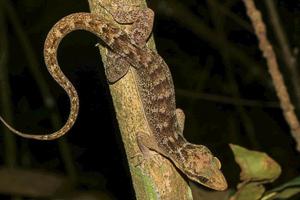
Christmas Island giant gecko. Photo: JP Emery.
Four out of the 5 native lizards on Christmas Island have been wiped out by invasive predators and competitors. The last remaining lizard species, the threatened Christmas Island giant gecko, is in serious danger. We’re conducting research to understand more about the gecko’s population, habitat, genetics and threats, to try and save this last remaining lizard species.
Ecology and conservation of the Christmas Island goshawk and hawk owl

Christmas Island goshawk (left) and Christmas Island hawk owl (right). Photos: Rohan Clarke.
The threatened Christmas Island hawk-owl (boobook) and Christmas Island goshawk are elusive and poorly understood species. As the island’s 2 apex predators, understanding the ecology of these threatened birds is vital for broader conservation efforts on Christmas Island. Our team is researching these birds to understand how they affect, and are affected by, other species on the island. This information will be used to help ensure the conservation of species and ecosystems on the island.
Rewilding Norfolk: closing management knowledge gaps for faunal restoration on islands
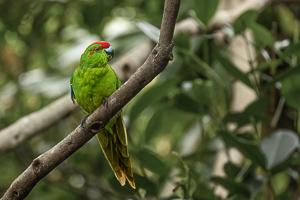
Norfolk Island green parrot. Photo: Paul W Kerr/AdobeStock.
Rats on Norfolk Island have been responsible for the extinction of several bird species, including the white-chested white-eye, Norfolk Island kaka and Tasman starling. To save other species such as the critically endangered Norfolk Island green parrot, our researchers are investigating the best strategies to effectively manage the populations of rats and other invasive predators, such as cats, on Norfolk Island.
Want to know more about the Resilient Landscapes Hub's activities and our research into practical solutions to environmental problems? Stay informed about activities, research, publications, events and more through the Hub newsletter.
"*" indicates required fields